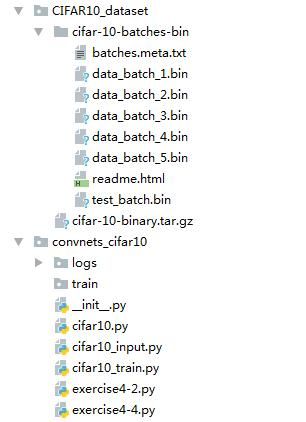4用于cifar10的卷积神经网络-4.4/4.5cifar10数据集读取和数据增强扩充(上/下)
4用于cifar10的卷积神经网络-4.4/4.5cifar10数据集读取和数据增强扩充(上/下)
参考:
https://github.com/tensorflow
http://www.cs.toronto.edu/~kriz/cifar.html
http://tensorflow.org/tutorials/deep_cnn/
https://github.com/tensorflow/models/tree/master/tutorials/image/cifar10
#-*- coding:utf-8 -*-
#实现简单卷积神经网络对MNIST数据集进行分类:conv2d + activation + pool + fc
import csv
import tensorflow as tf
import os
from tensorflow.examples.tutorials.mnist import input_data
os.environ['TF_CPP_MIN_LOG_LEVEL'] = '2'
import sys
from six.moves import urllib
import tarfile
import cifar10_input
# 设置算法超参数
learning_rate_init = 0.001
training_epochs = 1
batch_size = 100
display_step = 10
# Network Parameters
n_input = 784 # MNIST data input (img shape: 28*28)
# n_classes = 10 # MNIST total classes (0-9 digits)
#数据集中输入图像的参数
dataset_dir='../CIFAR10_dataset'
image_size = 24
image_channel = 3
n_classes = 10 #CiFar10中类的数量
#从网址下载数据集存放到data_dir指定的目录中
def maybe_download_and_extract(data_dir):
"""下载并解压缩数据集 from Alex's website."""
dest_directory = data_dir
DATA_URL = 'http://www.cs.toronto.edu/~kriz/cifar-10-binary.tar.gz'
if not os.path.exists(dest_directory):
os.makedirs(dest_directory)
filename = DATA_URL.split('/')[-1]
filepath = os.path.join(dest_directory, filename)
if not os.path.exists(filepath):
def _progress(count, block_size, total_size):
sys.stdout.write('\r>> Downloading %s %.1f%%' % (filename,
float(count * block_size) / float(total_size) * 100.0))
sys.stdout.flush()
filepath, _ = urllib.request.urlretrieve(DATA_URL, filepath, _progress)
print()
statinfo = os.stat(filepath)
print('Successfully downloaded', filename, statinfo.st_size, 'bytes.')
extracted_dir_path = os.path.join(dest_directory, 'cifar-10-batches-bin')
if not os.path.exists(extracted_dir_path):
tarfile.open(filepath, 'r:gz').extractall(dest_directory)
def get_distorted_train_batch(data_dir,batch_size):
"""Construct distorted input for CIFAR training using the Reader ops.
Returns:
images: Images. 4D tensor of [batch_size, IMAGE_SIZE, IMAGE_SIZE, 3] size.
labels: Labels. 1D tensor of [batch_size] size.
Raises:
ValueError: If no data_dir
"""
if not data_dir:
raise ValueError('Please supply a data_dir')
data_dir = os.path.join(data_dir, 'cifar-10-batches-bin')
images, labels = cifar10_input.distorted_inputs(data_dir=data_dir,batch_size=batch_size)
return images,labels
def get_undistorted_eval_batch(data_dir,eval_data, batch_size):
"""Construct input for CIFAR evaluation using the Reader ops.
Args:
eval_data: bool, indicating if one should use the train or eval data set.
Returns:
images: Images. 4D tensor of [batch_size, IMAGE_SIZE, IMAGE_SIZE, 3] size.
labels: Labels. 1D tensor of [batch_size] size.
Raises:
ValueError: If no data_dir
"""
if not data_dir:
raise ValueError('Please supply a data_dir')
data_dir = os.path.join(data_dir, 'cifar-10-batches-bin')
images, labels = cifar10_input.inputs(eval_data=eval_data,data_dir=data_dir,batch_size=batch_size)
return images,labels
#根据指定的维数返回初始化好的指定名称的权重 Variable
def WeightsVariable(shape, name_str, stddev=0.1):
# initial = tf.random_normal(shape=shape, stddev=stddev, dtype=tf.float32)
initial = tf.truncated_normal(shape=shape, stddev=stddev, dtype=tf.float32)
return tf.Variable(initial, dtype=tf.float32, name=name_str)
#根据指定的维数返回初始化好的指定名称的偏置 Variable
def BiasesVariable(shape, name_str, init_value=0.00001):
initial = tf.constant(init_value, shape=shape)
return tf.Variable(initial, dtype=tf.float32, name=name_str)
# 二维卷积层activation(conv2d+bias)的封装
def Conv2d(x, W, b, stride=1, padding='SAME',activation=tf.nn.relu,act_name='relu'):
with tf.name_scope('conv2d_bias'):
y = tf.nn.conv2d(x, W, strides=[1, stride, stride, 1], padding=padding)
y = tf.nn.bias_add(y, b)
with tf.name_scope(act_name):
y = activation(y)
return y
# 二维池化层pool的封装
def Pool2d(x, pool= tf.nn.max_pool, k=2, stride=2,padding='SAME'):
return pool(x, ksize=[1, k, k, 1], strides=[1, stride, stride, 1], padding=padding)
# 全连接层activate(wx+b)的封装
def FullyConnected(x, W, b, activate=tf.nn.relu, act_name='relu'):
with tf.name_scope('Wx_b'):
y = tf.matmul(x, W)
y = tf.add(y, b)
with tf.name_scope(act_name):
y = activate(y)
return y
def Inference(image_holder):
# 第一个卷积层activate(conv2d + biase)
with tf.name_scope('Conv2d_1'):
conv1_kernels_num = 64
weights = WeightsVariable(shape=[5, 5, image_channel, conv1_kernels_num],
name_str='weights',stddev=5e-2)
biases = BiasesVariable(shape=[conv1_kernels_num], name_str='biases',init_value=0.0)
conv1_out = Conv2d(image_holder, weights, biases, stride=1, padding='SAME')
# 第一个池化层(pool 2d)
with tf.name_scope('Pool2d_1'):
pool1_out = Pool2d(conv1_out, pool=tf.nn.max_pool, k=3, stride=2,padding='SAME')
# 第二个卷积层activate(conv2d + biase)
with tf.name_scope('Conv2d_2'):
conv2_kernels_num = 64
weights = WeightsVariable(shape=[5, 5, conv1_kernels_num, conv2_kernels_num],
name_str='weights', stddev=5e-2)
biases = BiasesVariable(shape=[conv2_kernels_num], name_str='biases', init_value=0.0)
conv2_out = Conv2d(pool1_out, weights, biases, stride=1, padding='SAME')
# 第二个池化层(pool 2d)
with tf.name_scope('Pool2d_2'):
pool2_out = Pool2d(conv2_out, pool=tf.nn.max_pool, k=3, stride=2, padding='SAME')
#将二维特征图变换为一维特征向量
with tf.name_scope('FeatsReshape'):
features = tf.reshape(pool2_out, [batch_size,-1])
feats_dim = features.get_shape()[1].value
# 第一个全连接层(fully connected layer)
with tf.name_scope('FC1_nonlinear'):
fc1_units_num = 384
weights = WeightsVariable(shape=[feats_dim, fc1_units_num],
name_str='weights',stddev=4e-2)
biases = BiasesVariable(shape=[fc1_units_num], name_str='biases',init_value=0.1)
fc1_out = FullyConnected(features, weights, biases, activate=tf.nn.relu, act_name='relu')
# 第二个全连接层(fully connected layer)
with tf.name_scope('FC2_nonlinear'):
fc2_units_num = 192
weights = WeightsVariable(shape=[fc1_units_num, fc2_units_num],
name_str='weights',stddev=4e-2)
biases = BiasesVariable(shape=[fc2_units_num], name_str='biases',init_value=0.1)
fc2_out = FullyConnected(fc1_out, weights, biases,activate=tf.nn.relu, act_name='relu')
# 第三个全连接层(fully connected layer)
with tf.name_scope('FC3_linear'):
fc3_units_num = n_classes
weights = WeightsVariable(shape=[fc2_units_num, fc3_units_num],
name_str='weights',stddev=1.0/fc2_units_num)
biases = BiasesVariable(shape=[fc3_units_num], name_str='biases',init_value=0.0)
logits = FullyConnected(fc2_out, weights, biases,activate=tf.identity, act_name='linear')
return logits
def TrainModel():
#调用上面写的函数构造计算图
with tf.Graph().as_default():
# 计算图输入
with tf.name_scope('Inputs'):
image_holder = tf.placeholder(tf.float32, [batch_size, image_size,image_size,image_channel], name='images')
labels_holder = tf.placeholder(tf.int32, [batch_size], name='labels')
# 计算图前向推断过程
with tf.name_scope('Inference'):
logits = Inference(image_holder)
# 定义损失层(loss layer)
with tf.name_scope('Loss'):
cross_entropy = tf.nn.sparse_softmax_cross_entropy_with_logits(labels=labels_holder,logits=logits)
cross_entropy_mean = tf.reduce_mean(cross_entropy)
total_loss = cross_entropy_mean
# 定义优化训练层(train layer)
with tf.name_scope('Train'):
learning_rate = tf.placeholder(tf.float32)
global_step = tf.Variable(0, name='global_step', trainable=False, dtype=tf.int64)
optimizer = tf.train.RMSPropOptimizer(learning_rate=learning_rate)
trainer_op = optimizer.minimize(total_loss,global_step=global_step)
# 定义模型评估层(evaluate layer)
with tf.name_scope('Evaluate'):
top_K_op = tf.nn.in_top_k(predictions=logits,targets=labels_holder,k=1)
#定义获取训练样本批次的计算节点
with tf.name_scope('GetTrainBatch'):
image_train,labels_train = get_distorted_train_batch(data_dir=dataset_dir,batch_size=batch_size)
# 定义获取测试样本批次的计算节点
with tf.name_scope('GetTestBatch'):
image_test, labels_test = get_undistorted_eval_batch(eval_data=True,data_dir=dataset_dir, batch_size=batch_size)
# 添加所有变量的初始化节点
init_op = tf.global_variables_initializer()
print('把计算图写入事件文件,在TensorBoard里面查看')
graph_writer = tf.summary.FileWriter(logdir='logs', graph=tf.get_default_graph())
graph_writer.close()
def main(argv=None):
maybe_download_and_extract(data_dir=dataset_dir)
train_dir='train/'
if tf.gfile.Exists(train_dir):
tf.gfile.DeleteRecursively(train_dir)
tf.gfile.MakeDirs(train_dir)
TrainModel()
if __name__ =='__main__':
tf.app.run()

